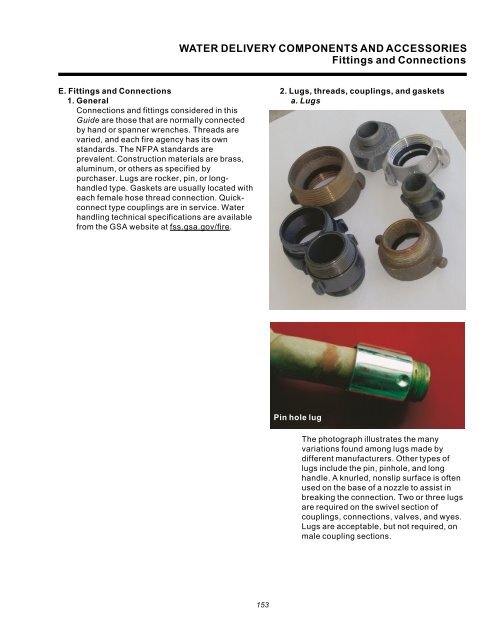Water Handling Equipment Guide - National Wildfire Coordinating ...
Water Handling Equipment Guide - National Wildfire Coordinating ...
Water Handling Equipment Guide - National Wildfire Coordinating ...
You also want an ePaper? Increase the reach of your titles
YUMPU automatically turns print PDFs into web optimized ePapers that Google loves.
WATER DELIVERY COMPONENTS AND ACCESSORIES<br />
Fittings and Connections<br />
E. Fittings and Connections<br />
1. General<br />
Connections and fittings considered in this<br />
<strong>Guide</strong> are those that are normally connected<br />
by hand or spanner wrenches. Threads are<br />
varied, and each fire agency has its own<br />
standards. The NFPA standards are<br />
prevalent. Construction materials are brass,<br />
aluminum, or others as specified by<br />
purchaser. Lugs are rocker, pin, or longhandled<br />
type. Gaskets are usually located with<br />
each female hose thread connection. Quickconnect<br />
type couplings are in service. <strong>Water</strong><br />
handling technical specifications are available<br />
from the GSA website at fss.gsa.gov/fire.<br />
2. Lugs, threads, couplings, and gaskets<br />
a. Lugs<br />
Pin hole lug<br />
The photograph illustrates the many<br />
variations found among lugs made by<br />
different manufacturers. Other types of<br />
lugs include the pin, pinhole, and long<br />
handle. A knurled, nonslip surface is often<br />
used on the base of a nozzle to assist in<br />
breaking the connection. Two or three lugs<br />
are required on the swivel section of<br />
couplings, connections, valves, and wyes.<br />
Lugs are acceptable, but not required, on<br />
male coupling sections.<br />
153
















